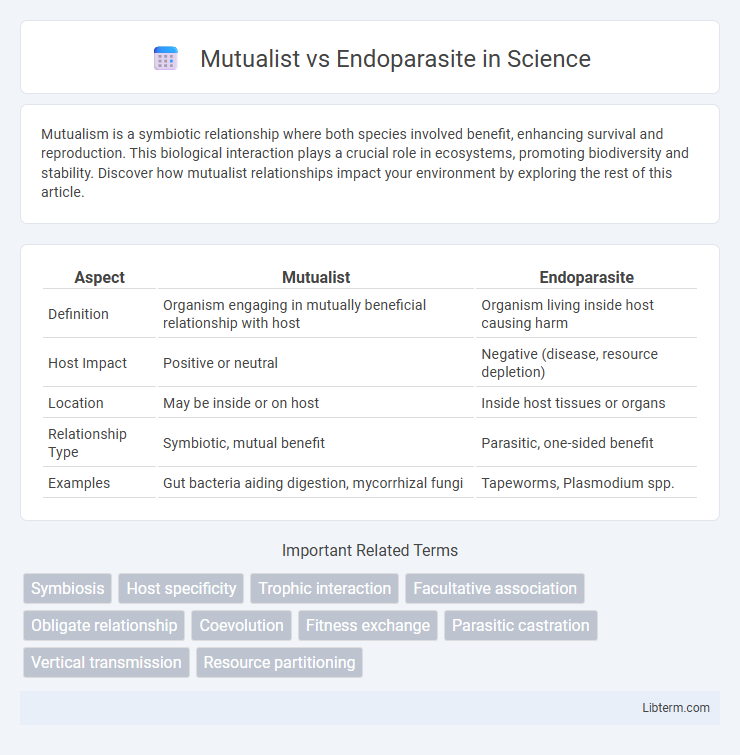Mutualism is a symbiotic relationship where both species involved benefit, enhancing survival and reproduction. This biological interaction plays a crucial role in ecosystems, promoting biodiversity and stability. Discover how mutualist relationships impact your environment by exploring the rest of this article.
Table of Comparison
| Aspect | Mutualist | Endoparasite |
|---|---|---|
| Definition | Organism engaging in mutually beneficial relationship with host | Organism living inside host causing harm |
| Host Impact | Positive or neutral | Negative (disease, resource depletion) |
| Location | May be inside or on host | Inside host tissues or organs |
| Relationship Type | Symbiotic, mutual benefit | Parasitic, one-sided benefit |
| Examples | Gut bacteria aiding digestion, mycorrhizal fungi | Tapeworms, Plasmodium spp. |
Introduction to Host-Symbiont Relationships
Mutualist and endoparasite interactions represent two distinct types of host-symbiont relationships, where mutualists provide benefits to their hosts through nutrient exchange or protection, enhancing host survival and fitness. Endoparasites reside inside host tissues, deriving nutrients at the host's expense, often causing disease or physiological stress that diminishes host health. Understanding the balance between these symbiotic associations illuminates ecological dynamics and evolutionary pressures shaping host and microbial adaptations.
Defining Mutualists: Partners in Survival
Mutualists are organisms engaged in a symbiotic relationship where both partners benefit from the association, enhancing each other's survival and reproductive success. Unlike endoparasites, which live inside a host and derive nutrients at the host's expense, mutualists exchange resources, protection, or other advantages that improve fitness for both species involved. This cooperative interaction often drives coevolution, fostering adaptations that strengthen mutual dependence and ecological balance.
Understanding Endoparasites: Hidden Invaders
Endoparasites are organisms that live inside the host's body, often within tissues or organs, extracting nutrients at the host's expense and causing various diseases. Unlike mutualists that benefit their hosts, endoparasites employ strategies such as immune evasion and manipulation of host physiology to ensure survival and reproduction. Common examples include tapeworms, flukes, and protozoans like Plasmodium, responsible for malaria, highlighting the significant health challenges posed by these hidden invaders.
The Biological Mechanisms of Mutualism
Mutualism involves intricate biological mechanisms such as nutrient exchange, chemical signaling, and structural adaptations that benefit both species involved. Specialized cells and molecular pathways facilitate resource sharing, enhancing survival and reproductive success. This symbiotic interaction contrasts with endoparasitism, where the parasite extracts resources at the host's expense, often manipulating host biology to its advantage.
Strategies and Adaptations of Endoparasites
Endoparasites have evolved specialized strategies and adaptations that enable them to survive, reproduce, and avoid host defenses within the internal environment of their hosts. They possess complex life cycles often involving multiple hosts and developmental stages, alongside physiological adaptations such as immune evasion mechanisms, nutrient absorption through specialized structures like teguments, and the ability to manipulate host biochemistry to create a favorable niche. These adaptations ensure sustained parasitism while minimizing detection and immune response, contrasting the mutually beneficial interactions typical of mutualists.
Ecological Roles and Impacts
Mutualists enhance ecosystem stability by facilitating nutrient cycling and promoting plant growth through symbiotic relationships, such as nitrogen-fixing bacteria in legume roots. Endoparasites, residing within host organisms, often reduce host fitness by extracting nutrients, which can influence population dynamics and community structure by controlling host abundance. These contrasting ecological roles highlight mutualists as key contributors to ecosystem productivity, while endoparasites serve as significant factors in regulating species interactions and biodiversity.
Mutualism vs Endoparasitism: Key Differences
Mutualism involves a symbiotic relationship where both species benefit, such as bees pollinating flowers while obtaining nectar. Endoparasitism occurs when one organism, the parasite, lives inside the host and derives nutrients at the host's expense, often causing harm, exemplified by tapeworms inhabiting the intestines of mammals. The key difference lies in mutualism's beneficial exchange, contrasting with endoparasitism's exploitative nature that negatively impacts the host.
Examples in Nature: Mutualists and Endoparasites
Mutualists include nitrogen-fixing bacteria like Rhizobium in legume root nodules, which enhance plant growth by converting atmospheric nitrogen into bioavailable forms, and mycorrhizal fungi that improve nutrient uptake in plants while receiving carbohydrates. Endoparasites consist of organisms such as tapeworms (Cestoda) residing in vertebrate intestines, absorbing nutrients at the host's expense, and Plasmodium species causing malaria within human blood cells. These examples highlight contrasting symbiotic relationships where mutualists provide reciprocal benefits, while endoparasites exploit host resources for survival.
Evolutionary Consequences of Each Relationship
Mutualist relationships drive coevolution by promoting reciprocal genetic adaptations that enhance survival and reproductive success of both species involved, fostering increased biodiversity and ecosystem stability. Endoparasite associations often result in evolutionary arms races, where host defenses and parasite evasion mechanisms continuously adapt, sometimes leading to host specialization or immune system complexity. Over time, mutualism tends to encourage cooperative traits and resource sharing, whereas endoparasitism can impose selective pressures that shape host resistance and parasite virulence strategies.
Implications for Human Health and Ecology
Mutualists provide essential benefits to human health by supporting immune function and nutrient absorption, as seen in gut microbiota, whereas endoparasites cause diseases that compromise health through tissue damage and immune evasion. Ecologically, mutualists enhance biodiversity and ecosystem productivity by facilitating nutrient cycling, while endoparasites regulate host populations and impact food web dynamics through parasitic relationships. Understanding these interactions informs disease control strategies and promotes ecosystem resilience by balancing host-microbe symbioses.
Mutualist Infographic

 libterm.com
libterm.com